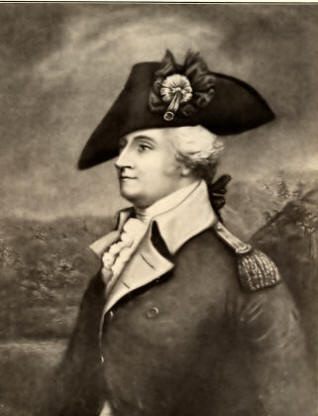General "Mad Anthony" Wayne
|
|
This Site:
|
After the surrender, the Pennsylvania line, under Wayne, marched to South Carolina, and their commander, with a part of them, was sent by General Greene to Georgia. On May 21, 1782, Colonel Brown marched out of Savannah in strong force to confront rapidly advancing Wayne. The latter got between Brown and Savannah, attacked him at midnight, and routed the whole party. This event occurred on the Ogeechce road, about 4miles southwest of Savannah. The vanguard of the Americans was composed of sixty horsemen and twenty infantry, led by Colonel Anthony Walton White. These made a spirited charge, killing or wounding forty of the British and making twenty of them prisoners. The sword and bayonet did the work. The Americans lost five killed and two wounded. On June 24 a part of Wayne's army, lying about 5 miles from Savannah, was fiercely attacked by a body of Creek Indians, who first drove the troops and took two pieces of artillery; but they were soon utterly routed by a spirited charge. The brief battle was fought hand-to-hand with swords, bayonets, and tomahawks, and fourteen Indians and two white men were killed. Guristersigo, a famous Creek chief, was killed. The royalists coming out of Savannah to assist the Indians were driven back, with the loss of a standard and 127 horses with packs. The men fled back to the city, and soon afterwards evacuated it. Wayne took possession of the city, and of the province of Georgia, which had been held by the British military commanders about four years. It was estimated that Georgia lost in the war 1,000 of its citizens and 4,000 of its slaves (see GEORGIA; SAVANNAH, EVACUATION OF). In 1784–85 Wayne served in the Pennsylvania Assembly, and in the convention that ratified the national Constitution. In April, 1792, he was made general-in-chief of the army. The defeat of GENERAL ARTHUR ST. CLAIR spread alarm along the frontiers and indignation throughout the country. General Wayne was appointed his successor. Apprehending that pending negotiations with the Indians, if they failed, would be followed by immediate hostilities against the frontier, Wayne marched into the Northwestern Territory in the autumn of 1793 with a competent force. He spent the winter at Greenvile, not far from the place of St. Clair's disaster, and built a stockade, which he named Fort Recovery. The following summer he pushed on through the wilderness towards the Maumee, and at its junction with the Auglaize he built Fort Defiance. On the St. Mary's he built Fort Adams as an intermediate post; and in August he went down the Maumee with 1,000 men and encamped near a British post at the foot of the Maumee Rapids, called Fort Miami, or Maumee. Wayne, with a force ample to destroy the Indians in spite of British influence, willing to spare bloodshed, offered them peace and tranquility if they would lay down their weapons. They refused. Wayne then advanced to the head of the rapids, and at a place called Fallen Timbers, not far above (present) Maumee City, he attacked and defeated the Indians on August 20. Almost all the dead warriors were found with British arms. Wayne laid waste their country, and at the middle of September moved up to the junction of the St. Mary's and St. Joseph's rivers, near the (present) city of Fort Wayne, Ind., and built a strong fortification which lie named Fort Wayne. The little army wintered at Greenville. The Indians perceived their own weakness and sued for peace. The following summer about 1,100 sachems and warriors, representing twelve cantons, met (August 3, 1795) commissioners of the United States at Greenville. and made a treaty of peace. Brave to the verge of rashness, Wayne received the name of "Mad Anthony." Yet he was discreet and cautious, fruitful in resources, and prompt in the execution of plans. After his successful campaign against the Indians, he returned to Fort Presque Isle (now Erie), Pa., where he died, December 15, 1796. His body was afterwards removed by his son and buried in Radnor churchyard, in his native county. Over his remains the Pennsylvania Society of the Cincinnati caused a neat marble monument to be erected in 1809. |
|
|
||
|
|
Site Copyright 2003-2018 Son of the South. For Questions or comments about this collection, contact: paul@sonofthesouth.net |
|
|
Are you Scared and Confused? Read My Snake Story, a story of hope and encouragement, to help you face your fears. |
||
 Wayne,
ANTHONY, military officer; born in Easttown, Chester co.,
Wayne,
ANTHONY, military officer; born in Easttown, Chester co.,